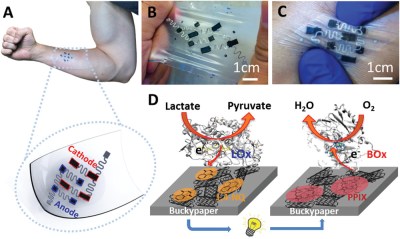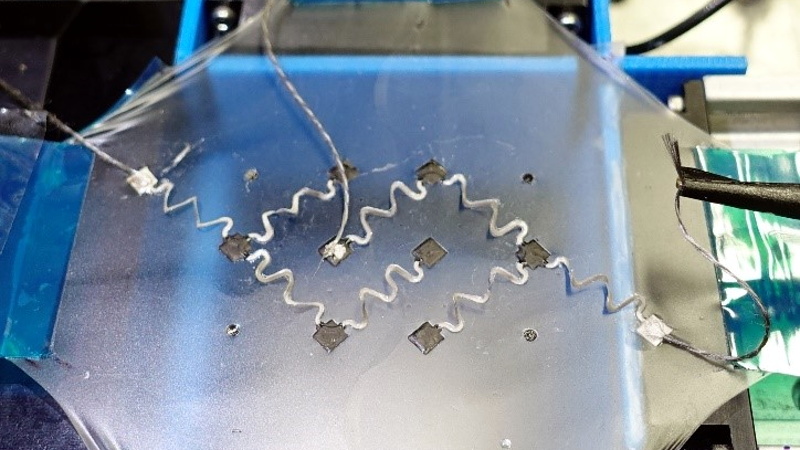Researchers from l’Université Grenoble Alpes and the University of San Diego recently developed and patented a flexible device that’s able to produce electrical energy from human sweat. The lactate/O2 biofuel cell has been demonstrated to light an LED, leading to further development in the area of harvesting energy through wearables.

Scientists have developed a flexible conductive material made up of carbon nanotubes, cross-linked polymers, and enzymes connected to each and printed through screen-printing. This type of composite is known as a buckypaper, and uses the carbon nanotubes as the electrode material.
The lactate oxidase works as the anode and the bilirubin oxidase (from the yellowish compound found in blood) as the cathode. Given the theoretical high power density of lactate, this technology has the potential to produce even more power than its current power generation of 450 µW.

At the moment, the biggest cost for production is the price of the enzymes that transform the compounds in sweat. Beyond cost considerations, the researchers also need to look at ways to increase the voltage in order to power larger portable devices.
With all the exciting research surrounding wearable technology right now, hopefully we’ll be hearing about further developments and applications from this research group soon!
[Thanks to Qes for the tip!]















This has got to be the least efficient way for humans to generate electricity. Lactate based fuel cells might make sense under certain conditions, but not as a way for humans to generate meaningful amounts of electricity using sweat.
Seems more like something that was just an exercise in engineering vs anything that could be practical.
You’d harvest a lot more energy with a weight and a spring in a tube or putting peizo electric material in the insoles.
For things like sensors on the skin that can be placed anywhere, it might be a good idea. The US military are constantly trying to turn their grunts into killer futuristic cyborgs, so there’s lots of money in it. But medical use would be another, and sports. The advantage of sweat over muscle power, is that it’s available anywhere on the skin, any time of day. You might want to put something insulating over it to keep the skin underneath warm, and make sure to wear warm clothes.
It’s also much less invasive than methods that use blood chemicals to produce power, so much easier to experiment with, no ethics committees or unfortunate infections.
Welcome to the matrix, Neo.
Very good!
Might look a bit silly with this strapped to my forehead.
Well you can always stick in a place where the sun doesn’t shine (or close to it). Chances are that it might work even better.
For energy harvesting from humans, it’s unlikely that any one strategy will generate enough. The thought isn’t to use just this fuel cell, or just piezo- or thermalelectrics. It’s an all of the above strategy. Get a trickle of current from each source we can find and maybe just maybe we can have enough to power something useful.
The human body is very inefficient, all that energy is coming from expensive human food and the vast resources required to produce it. Quite literally any other source of energy would be more efficient. You can probably generate more energy by literally burning the cash you would have spent on this gear.
What do you mean the human body is very inefficient? Do you have anything to back up that claim? I would have thought that the human body is extremely efficient and uses or stores practically all the energy available from the food we eat.
Perpetuum mobile, my sweaty ass!
The start of a Freman Still suit….(Dune)
Energy from sweat from l’Université Grenoble Alpes, eh? Should I make a joke about the French and bathing or shouldn’t I? Choices, choices…
Did you know bilirubin is the stuff that makes shit brown? It’s produced from the breakdown of red blood cells. People who don’t produce it, with certain liver illnesses, say, crap out beige poop.